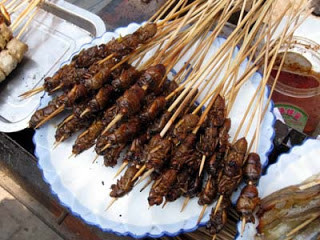Cicada Swarm 2013: A Pictorial Guide To The Bug Plague Looming Over The East Coast [PHOTOS]
Get your earplugs ready: The cicadas are coming.
All around the Northeast -- from Pennsylvania to Maryland to Connecticut -- billions of cicadas are starting to emerge from the ground after 17 years of underground adolescence mostly spent feeding on the fluid inside tree roots.
While this emergence is the biggest in the Northeastern U.S. in a long while, the Southern states have had recent visits too. There are about 15 distinct broods of cicadas that emerge regularly in the U.S. In 2011, the Great Southern Brood popped up across the American Southeast.
Members of Magicicada, the genus that includes cicadas with both 13-year and 17-year life cycles, pop up when the soil temperature about 8 inches down is consistently above 63 degrees Fahrenheit.
When they first emerge, they’re still in their adolescent “nymph” form, which looks something like a cross between a cockroach and a wingless wasp.
After emerging, the nymph molts into its more familiar winged form, which appears ghostly white at first but darkens as the insect’s exoskeleton hardens.
Then, the cicada has just one mission in the few weeks it has left to live: find a mate and procreate.
[cicadaswarm: Flickr/woodleywonderworks]
The males congregate in big groups on trees and issue their thundering, chittering mating calls, which can reach noise levels of around 100 decibels -- as loud as a gas lawn mower revving up three feet from your ear.
A male cicada makes all that commotion using special membranes on its abdomen called tymbals. The cicada rapidly contracts and relaxes the muscles attached to the tymbal, which pops back and forth like the top of an empty soda can, according to the Great Plains Nature Center.
All that noise attracts not only interested females but also lots of creatures who know a good meal when they hear one. The emergence creates a smorgasbord for predators including birds and larger insects like the digger wasp Sphecius speciosus, often called the "cicada killer."
The cicada below had been attacked by a bird and expired shortly after the photo was taken:
Cicadas don’t have much of a defense against predators with stingers or poison. Some scientists think that the cicada’s life-cycle is the species’ survival strategy: By emerging in such overwhelming numbers, the cicadas are playing the odds. It’s a game called “Well, They Probably Can’t Eat All Of Us.”
Speaking of eating cicadas, they’re actually quite edible. You can fry them up like popcorn shrimp, or spear them on a stick and roast them like a shish kebab. They are rumored to have tasting notes of almonds and fried egg whites.
If the noise really gets to you, that could be sweet (savory?) revenge!

Something to keep in mind if the noise starts to get to you!
© Copyright IBTimes 2024. All rights reserved.











